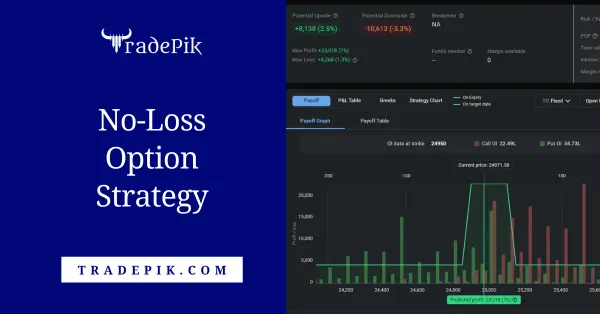Low-Risk, High-Reward: Nifty Option Strategy for August 2024 (Bearish Collar)
Navigate uncertain markets with a bearish collar options strategy for Nifty's August expiry. Manage risk, protect gains, and potentially profit from a downturn.

The allure of the stock market is undeniable, but the swings and roundabouts can leave even seasoned investors feeling a bit queasy. If you're eyeing Nifty's August expiry with a hint of caution, you're not alone. Let's face it, sometimes the smartest move is to play a bit of defence.
Here's a sobering stat: Studies suggest that around 70% of active traders lose money in the market. Ouch. But that doesn't mean you can't be part of the winning 30%. It's all about having the right tools and strategies in your arsenal.
Today, we're shining the spotlight on the bearish collar – an options strategy that offers a clever blend of protection and profit potential. It's like having your cake and eating it too (well, sort of).
In this article, we'll break down the bearish collar, explain why it's a smart play in the current market climate, and how to potentially implement it for Nifty's August expiry. So, buckle up, and let's explore this powerful strategy!
The Bearish Collar: Your Safety Net in a Shaky Market
Let's face it: the market can be unpredictable. At times, it can be volatile, causing investors to seek protection. If you are bearish about Nifty for the August expiry, you might consider using a bearish collar strategy. This approach can act as a financial safety net, providing protection from potential losses while still allowing for some potential gains.
So, what exactly is a Bearish Collar?
Imagine this: You're bearish with Nifty futures. You could just sell your futures, but what if you're wrong, and the market actually goes up? You'd miss out on those gains.
That's where the bearish collar comes in. It's like buying insurance for your Nifty futures position. Here's the breakdown:
- Sell Nifty Futures: You start by selling Nifty futures contracts. This sets the stage for your bearish outlook.
- Sell an OTM Put Option: Next, you sell an out-of-the-money (OTM) put option. This means the strike price of the put is lower than the current Nifty level. By selling this put, you're collecting a premium (cash upfront) while taking on the obligation to buy Nifty at the strike price if it falls below that level by expiry.
- Buy an OTM Call Option: Finally, you buy an OTM call option. This means the strike price of the call is higher than the current Nifty level. This acts as your insurance policy. If Nifty unexpectedly rallies, the call option will gain value, offsetting some of the potential losses on your short futures position.

The Bottom Line:
- Limited Downside: If Nifty falls, your short futures position will profit, and the sold put option will likely expire worthless. The call option will limit your losses if Nifty goes up significantly.
- Capped Upside: The call option you bought limits your potential losses if Nifty rallies. However, it also acts as your safety net, protecting you from substantial losses.
- Net Premium: Ideally, the premium you receive from selling the put option should partially or fully cover the cost of buying the call option. This reduces your overall cost and enhances the potential profitability of the strategy.
The bearish collar strategy emphasizes playing smart defense in a volatile market rather than swinging for the fences. It reflects a cautious outlook but still allows for some upside participation if the market surprises you.
Let's move on to explore why this might be a particularly fitting strategy for the current Nifty scenario.
Why a Bearish Collar for Nifty's August Expiry?

The Nifty chart is showing a clear uptrend but is currently pulling back and testing the ascending trendline support. This pullback, coupled with the potential double-top formation near the all-time high, hints at a possible short-term correction. A bearish collar strategy could be suitable in this scenario as it allows you to:
- Protect your long positions: If the market does correct, the short futures and sold put will allow for some downside participation, although gains will be capped.
- Participate in limited upside: If the uptrend resumes, the bought call option will provide a cushion against losses.
- Generate income: In a slightly bearish market, the future you sold could add profit to your returns.
Essentially, a bearish collar offers a balance between protection and potential profit, making it a strategic choice for traders who are cautiously bullish but want to safeguard their portfolios against a possible downturn.
Bearish Collar for Nifty for August Expiry
The ideal setup for a bearish collar strategy is:
- Sell Future
- But ATM Call
- Sell OTM Put
But I did some optimisation here that not only reduced our loss but improved our overall return too for the strategy. Let's look at the below image:

In the above strategy, you can see risk is just ₹17,000 but reward is ₹33,000 which is around 12% of the capital.
This optimised strategy we teach in our "Option Strategies: A Mentorship Program". In this program, we teach:
- How to select stocks for this strategy?
- How to find exact entry points?
- How to optimise it for a better risk: reward?
- And How to adjust if script is not moving based on your expectations.
Want to Unlock the Exact Strategy?
We understand that the specifics of this strategy – the precise strike prices, option expiry dates, and risk management techniques – are what truly bring it to life. That's why we're offering this valuable information exclusively to our subscribers.
By subscribing to our premium plan, you'll gain access to:
- The exact bearish collar setup for Nifty's August 2024 expiry, including specific strike prices and option types.
- Other Premium Option Strategies and Menbers-Only Content.
- Ongoing analysis and updates about the adjustments on the strategy as the market evolves.





